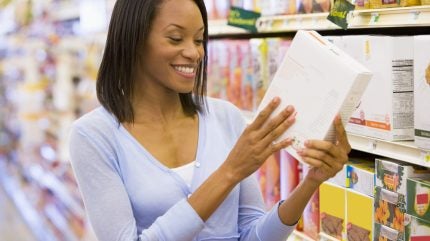
The “clean label” movement in packaging is redefining how consumers interact with products—especially in the food and beverage sector. More than a fleeting trend, this shift is rooted in a growing global demand for transparency, simplicity, and sustainability.
Consumers are increasingly looking beyond marketing claims, examining ingredient lists and packaging for signs of integrity, ethics, and environmental responsibility.

Discover B2B Marketing That Performs
Combine business intelligence and editorial excellence to reach engaged professionals across 36 leading media platforms.
While once the term “clean label” referred solely to food contents, it now encompasses a broader ethos: clarity about sourcing, production methods, and environmental impact.
As a result, brands are rethinking not just their ingredients but also their packaging choices, supply chains, and overall approach to sustainability.
What defines a clean label product?
At its core, the clean label philosophy prioritises simplicity and transparency. Shoppers are gravitating toward products with short ingredient lists made up of familiar, easily recognisable items.
Labels that feature whole grains, fruits, vegetables, and plant-based proteins are now seen as more appealing than those packed with synthetic additives and preservatives.

US Tariffs are shifting - will you react or anticipate?
Don’t let policy changes catch you off guard. Stay proactive with real-time data and expert analysis.
By GlobalDataNatural ingredients are a central pillar of clean label products. Consumers are showing a strong preference for items free from artificial colours, flavours, and chemical preservatives.
This trend is mirrored in packaging too—buyers are keen to avoid plastics and other environmentally harmful materials, favouring recyclable, compostable or biodegradable options.
Transparency is another crucial factor. Brands that clearly communicate where ingredients are sourced, how products are made, and what materials are used in packaging are rewarded with customer loyalty.
Certifications like Fair Trade, Rainforest Alliance, and organic labelling help provide that assurance.
The clean label movement has raised the bar: vague terms such as “natural” or “eco-friendly” are no longer sufficient on their own.
Finally, ethical and sustainable sourcing is gaining traction as part of the clean label expectation.
Consumers are increasingly aware of how their choices affect global supply chains, animal welfare, and the planet’s health. As such, clean label is evolving into a holistic standard—one that considers both the product and the broader systems behind it.
How clean label is transforming packaging
Packaging plays a vital role in how clean label values are communicated—and increasingly, whether a product aligns with consumer expectations. Beyond aesthetics, today’s packaging must convey a story of honesty, health, and responsibility.
Many manufacturers are reformulating their products not only to reduce artificial additives but also to ensure the packaging matches the clean label promise.
This has led to an uptick in the use of sustainable packaging materials, such as paper, cardboard, glass, and bioplastics derived from renewable sources.
Minimalist design is a hallmark of clean label packaging. Busy, overly technical packaging has given way to clean lines, legible typography, and straightforward ingredient lists. This visual clarity reflects the product’s integrity and helps build trust at the shelf.
Equally important is increased supply chain transparency. QR codes, blockchain tracking, and detailed product traceability features allow consumers to learn about the journey from farm to shelf.
These innovations empower buyers and provide brands with a platform to showcase ethical practices.
The clean label movement also places pressure on companies to rethink sourcing and production. Clean label packaging is not just about what’s left out (like plastic or synthetic dyes) but also what’s included—recycled content, renewable materials, and ethically sourced resources.
Why consumers are embracing clean label packaging
Rising concerns around health, wellness, and environmental impact are fuelling the clean label revolution. Consumers are more informed than ever and increasingly choose brands that reflect their values.
Clean label packaging is associated with healthier lifestyles. Products that declare simple ingredients and eco-conscious packaging are often perceived as more wholesome and trustworthy. Shoppers—particularly Millennials and Gen Z—are prepared to pay more for goods that match their ethical and wellness priorities.
There is also a growing demand for transparency and traceability. In an era of digital information and social responsibility, consumers want brands to be honest and open. Clean label packaging, with its emphasis on legibility and accountability, becomes a critical trust-building tool.
Beyond individual health, the clean label movement is aligned with environmental consciousness. As awareness around climate change and plastic pollution increases, consumers are actively seeking products with lower environmental footprints.
Compostable wrappers, refillable containers, and minimal packaging waste are now key purchase influencers.
Ultimately, clean label packaging responds to a deep consumer desire for authenticity. It’s no longer enough for brands to make vague health claims—they must demonstrate clear actions, ethical standards, and a tangible commitment to sustainability.
Looking ahead
The clean label movement in packaging is more than just a marketing trend—it represents a paradigm shift in how products are made, labelled, and delivered.
With an emphasis on simplicity, transparency, and sustainability, clean label has become a powerful force shaping consumer behaviour and brand strategy alike.
As expectations continue to evolve, companies that embrace clean label principles—through both ingredient reformulation and packaging innovation—will be well-positioned to earn consumer trust and stand out in a competitive market.
In a world where clarity is king, clean label is the new gold standard.





